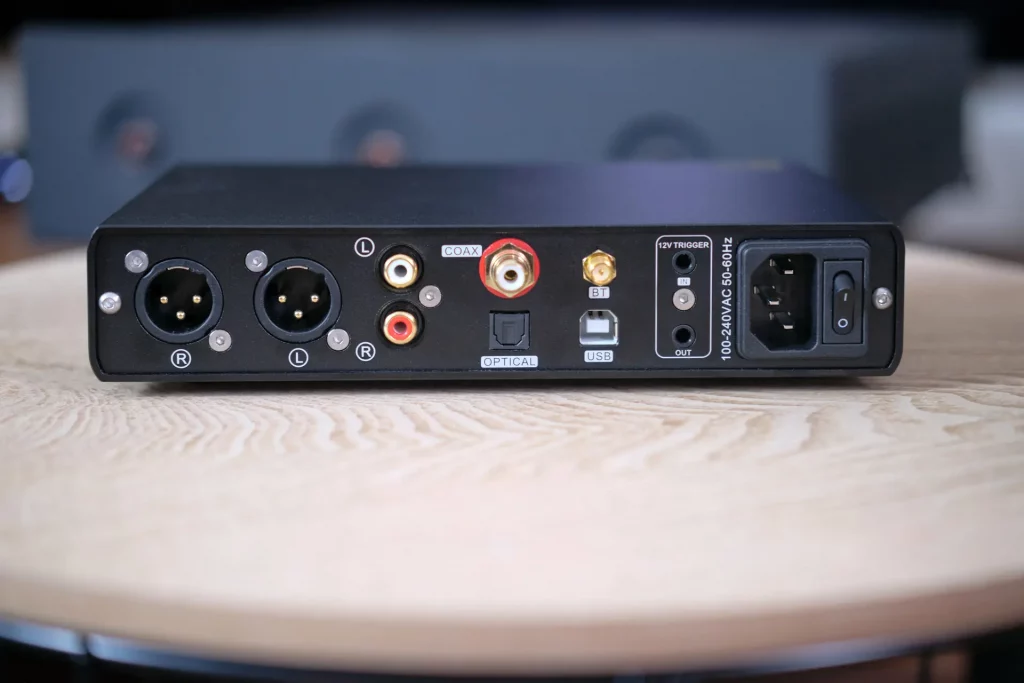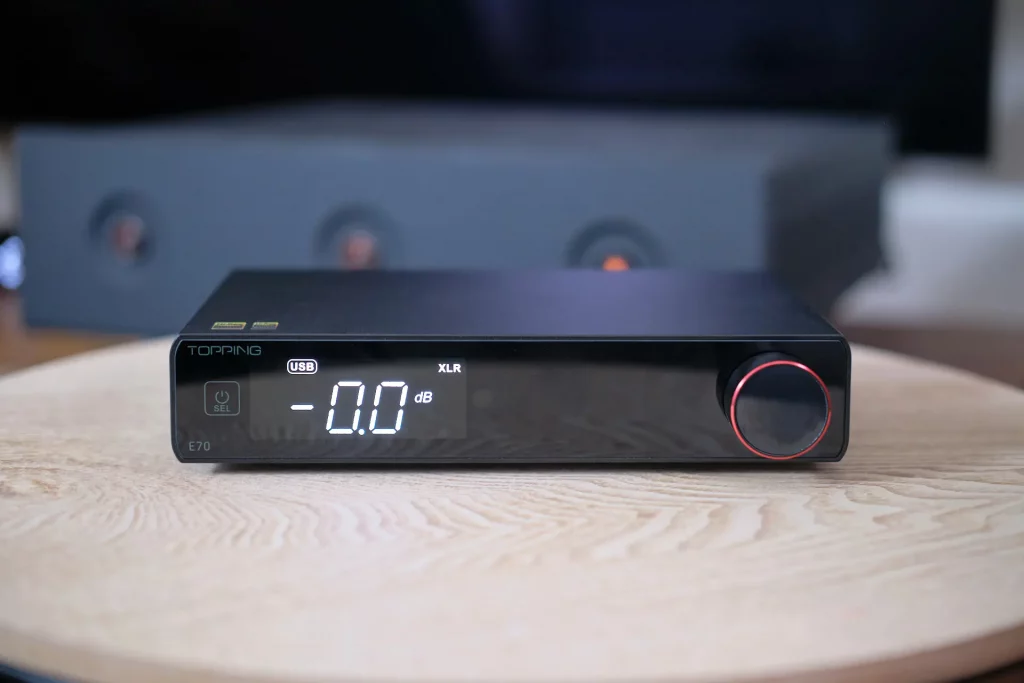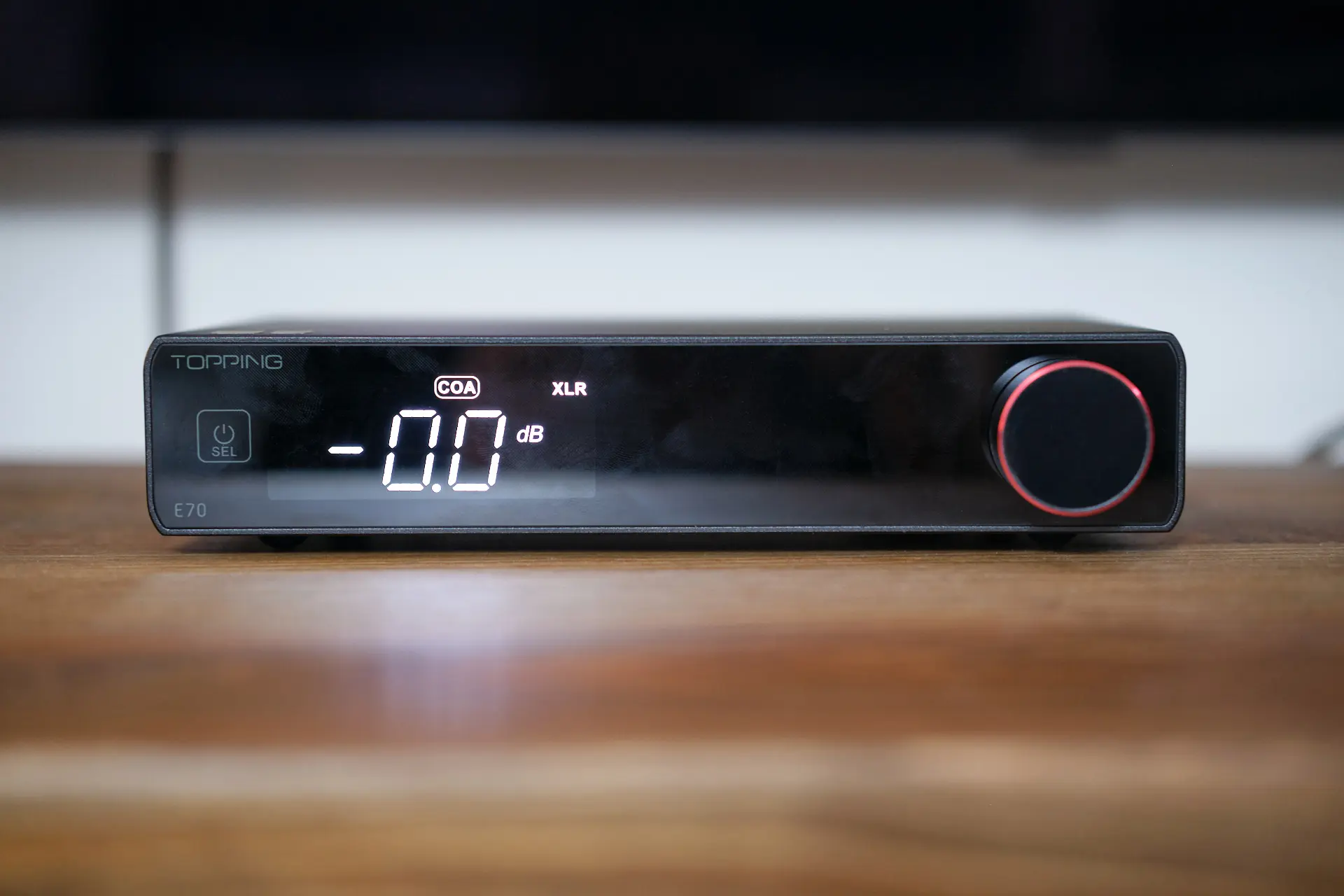Topping has established itself as a well-known name amongst good and affordable products, but E70 faces some seriously skilled competition at its price. So let’s not lose our time by making this intro longer than it needs to be and let’s get this review going.
Build and Features
Topping E70 follows the design language of its predecessor E30 and E50. This means that most of the device is wrapped inside an aluminum casing that comes in either black or silver. The front panel is always black and made out of scratch-resistant glass. You control it using a touch-sensitive button on the left and a volume knob that doubles as a button on the right. A small remote control is also onboard which is useful for choosing inputs and changing volume without moving from the sofa.
In the back, we see the usual digital inputs such as USB, optical, and coaxial, but there’s also Bluetooth onboard. Regarding analog outs, we can choose between single-ended RCA and balanced XLR ones. Both of these can be used in a fixed or variable output level mode. The AC power connector on the right means that E70 is powered directly from the wall socket and there’s no need for an AC/DC adapter.


In the heart of the device, there is a Sabre ES9028Pro DAC chip. It is accompanied by a powerful signal processor in the form of XMOS XU-316, enabling the highest possible PCM and DSD resolutions. But the chips being used are only one part of the story. The sound of a DAC as a whole device depends as much on the quality of the power supply and the output stage. Topping doesn’t say much about these but that’s why you have me – to put it through the real-life test and see how it performs.
Sound
Luckily, Topping E70 doesn’t disappoint, and it sounds very lush and full. The bassline, midbass included, is deep and pleasantly warm. This lends a slight warmth and richness to the midrange which is a welcome change from some colder and analytical Toppings of old. This results in the richest and most natural tone timbre that I’ve ever heard on a Topping DAC so far. Going to the midrange, E70 is still a full and rich-sounding DAC. Detail retrieval is satisfactory and so is the inner-tone texture. That said E70 is not a type of DAC that focuses on the super crisp and clean edges. Those are presented softer and warmer than on any Topping DAC I’ve previously tested which makes E70 more musical. Highs are slightly rolled off, making this DAC slightly darker sounding but avoiding any sort of hardness or harshness. There’s nothing to complain about E70’s tonality really, it’s a skillful balance between gentle warmth and transparency that provides a mostly natural and pleasant sound signature with laid-back highs.
The soundstaging is very good too, E70 spreads and layers all tones in a reasonably wide soundstage. Perception of depth is not its strong suit but basically no DAC at this price point can do it much better so I can’t hold that against it. Dynamics are good and this Topping sounds alive and engaging thanks to it. It has enough speed to follow the fast rhythm if needed but it will never sound relentless, analytical, or mechanically precise. No, E70 is actually a very smooth and slightly warmer-sounding DAC that gets musical flow quite well.
Comparisons
Topping E70 Velvet is a version of this DAC with a flagship AK chip instead of this slightly more modest Sabre. It’s $100 more expensive too. These two share the looks but also they share most of their sound signature too. Both are slightly warm, very smooth, full-bodied, and rich in tone timbre. The difference kicks in mostly in the upper parts of the frequency spectrum where E70 is somewhat darker sounding. E70 velvet feels more open, more airy, and in the process reveals a bit more about what’s going on in the recording in those upper parts. That’s all there is to it and I have to say that I did prefer the velvet version for its open and more revealing upper registers. But if your system is overly bright already, you might as well go with a more affordable and darker E70.
SMSL SU-9 pro I tested just before this one is $150 more expensive. This SMSL DAC is absolutely great and I scored it appropriately. Dynamics are comparable, and a good tone timbre. SU-9 pro has a slightly more laid-back lower midrange, and because of that some vocals and instruments might appear more laid back in the soundstage, making for a sensation of a deeper soundstaging. E70 has a more forward presentation with a slightly fuller and warmer midrange that appears closer to the listener, but less spacious. SU-9 pro sound more open and airy, and retrieves micro details from the recording a bit better too. All in all, I find that SU-9 pro offers slightly more complete sound, but given the price difference Topping E70 puts a great fight.
Conclusion
A solid build is already expected from Topping and that’s delivered without a doubt. Traditionally great value is once again here because you’ll have trouble finding a more complete and better-sounding product for the price. What’s new is this more mature and natural approach to the overall sound signature. This is one of the most musical Toppings ever released, and also one of the best DACs for its very modest price tag. If you don’t mind slightly fuller and darker tonality, E70 is a no-brainer recomendation.
| TOPPING E70 – CHARACTERISTICS |
|
DAC chip: Sabre ES9028Pro |





